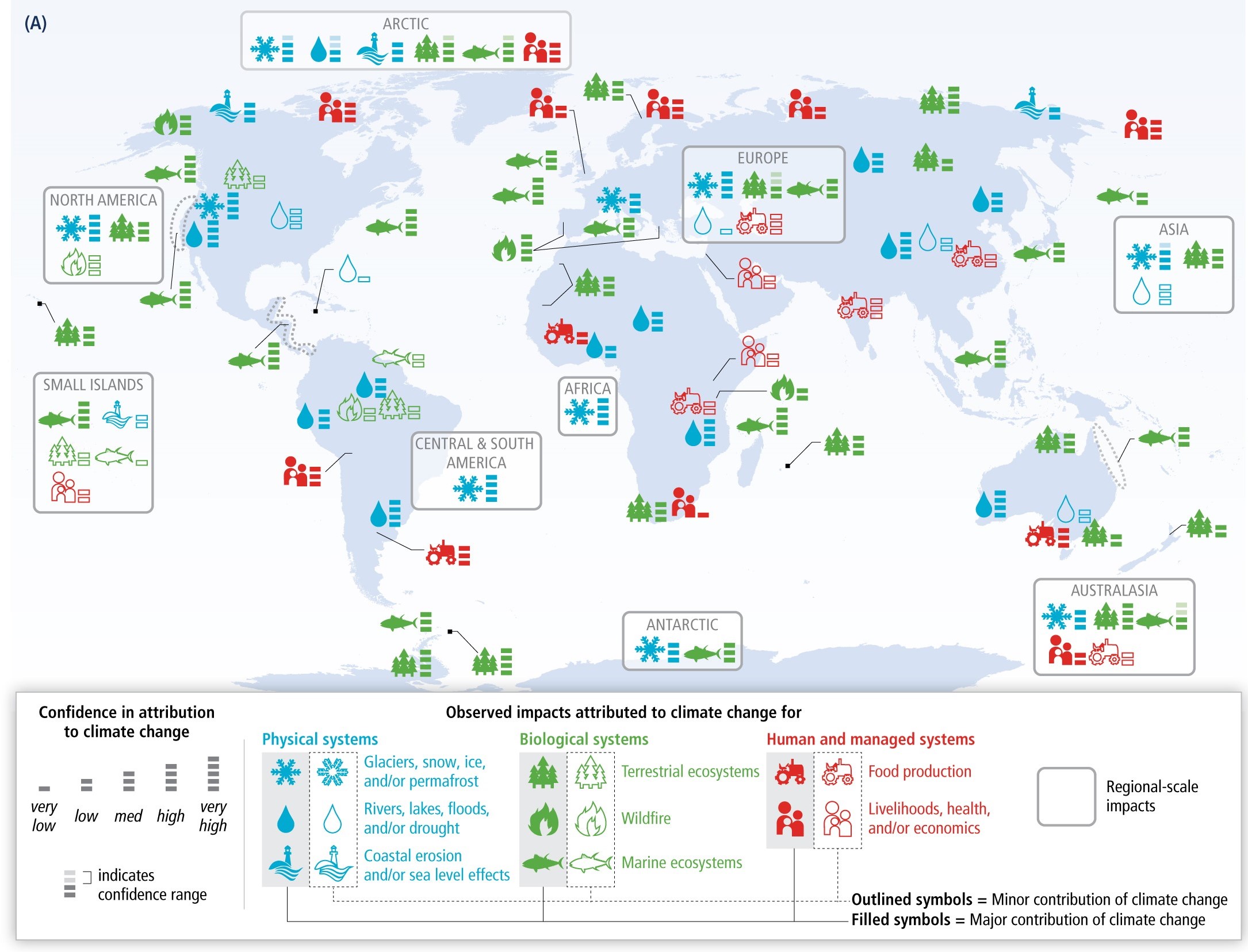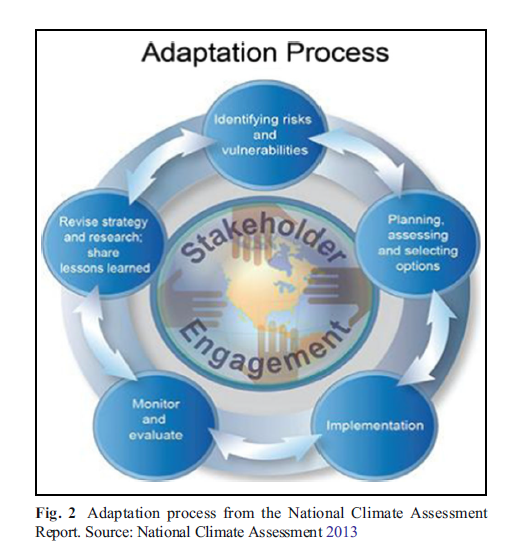Module 2: Climate Change Adaptation Policy: A Deep Dive
In this module (Module 2) you will become more familiar with the overall policy landscape for climate adaptation. While Modules 3 and 4 will narrow down and look more closely at policy in your own professional disciplinary areas, or work you manage in your government role, it is important to first know something about where those more specific policies came from – which is from the public policy space. This space includes: International, Federal, Provincial, Local and First Nations policy areas.
We will look at these policy spaces through three lenses: a) policy gaps due to climate uncertainty (International), b) stakeholder involvement in policy development (Federal), and c) policy innovation (Local).
So what will you be doing in this module? You will review lecture material, contribute to discussions based on some readings, and watch videos with expert interviews:
TOPIC #1: Climate Adaptation, Uncertainty, and Policy Gaps (International policy example)
TOPIC #2: Climate Adaptation Policy and Stakeholder Involvement (Federal policy example)
TOPIC #3: Climate Adaptation Policy Innovation (Local policy example)
Note: There are also sections in this module for both Provincial and First Nations policy, but for these, there are readings only.
Topic #1 Reading
The complete 2014 International Panel on Climate Change (IPCC) AR5 Climate Change 2014: Impacts, Adaptation, and Vulnerability report is almost 1800 pages long. In that document, the word uncertainty appears 588 times! How on earth do we make decisions in the face of so much uncertainty!
Scientists deal with uncertainty by being extremely conservative in their communications. We can see this in the cropped image below: “Observed Impacts Attributed to Climate Change” from this same report. Full image is here (Summary for Policymakers\/Graphics/Figure SPM2): https://www.ipcc.ch/report/ar5/wg2/
On the left hand side of the legend below, you can see a box labelled “Confidence in Attribution“. The number of stacked bars here indicates a measure of how confident IPCC scientists are about whether the specific impacts seen on the map are related to climate change. You can see they are very confident in some areas, and less confident in others. Being transparent about uncertainty is an important part of communication about science. So, how do policy makers deal with climate change adaptation uncertainty? Let’s talk about that in the Topic #1 Discussion next.
Please review Section A of this Summary, which includes both A2-Adaptation Experience and A3-The Decision-making Context. This reading is about 7 pages in total:
IPCC Climate Change Fifth Assessment Report / Impacts, Adaptation and Vulnerability. Summary for Policy Makers (2014) https://www.ipcc.ch/site/assets/uploads/2018/02/ar5_wgII_spm_en.pdf
Fig. SPM2. IPCC AR5 Summary for Policymakers. Found in: IPCC, 2014: Summary for policymakers. In: Climate Change 2014: Impacts, Adaptation, and Vulnerability.Part A: Global and Sectoral Aspects. Contribution of Working Group II to the Fifth Assessment Report of the Intergovernmental Panel on Climate Change [Field, C.B., V.R. Barros, D.J. Dokken, K.J. Mach, M.D. Mastrandrea, T.E. Bilir, M. Chatterjee, K.L. Ebi, Y.O. Estrada, R.C. Genova, B. Girma, E.S. Kissel, A.N. Levy, S. MacCracken, P.R. Mastrandrea, and L.L. White (eds.)]. Cambridge University Press, Cambridge, United Kingdom and New York, NY, USA, pp. 1-32.
Topic #1: Discussion
Designing and implementing climate change adaptation policy is not easy, including in the face of uncertainty about severity and timing of impacts. How much flooding will we see? How hot will our summers be next year, or five years from now?
As you read in the IPCC Summary for Policy Makers above, the decision-making context for addressing these issues is complicated and challenging. Based on what you learned in the reading of Section A2 and A3 (in particular), please click on the link above to start a new thread and respond to the following question, through the lens of your own discipline:
How should policymakers deal with climate change adaptation uncertainty in making economic, social, or other kinds of decisions?
Please respond to posts from others as well, so we can have a conversation on this topic.
Topic #2: Reading
In general, public policy is implemented by government bodies. So, a citizen, and as a professional in your particular field, how do you see your role as an actor in the climate change adaptation policy space? Are you a policy ‘taker’, or are you also a policy ‘maker’?
The figure below (28.2) from the 2014 US National Climate Assessment Report (full report here): https://nca2014.globalchange.gov/report/response-strategies/adaptation shows a variety of areas in which stakeholders may be involved in helping develop government led climate adaptation policy. These may include: identification of risks; planning, implementing and monitoring options; or revising and communicating options as needed. Do you see a role for yourself, or for your profession here?
In Canada, our main climate change policy document is the Federal Government’s Pan-Canadian Framework on Clean Growth and Climate Change (2016). Please review pages 27 to 35 of it (Adaptation and Climate Resilience), in order to participate in the Topic #2 discussion coming next below: http://publications.gc.ca/site/archivee-archived.html?url=http://publications.gc.ca/collections/collection_2017/eccc/En4-294-2016-eng.pdf
Topic #2: Discussion
Were you personally, or professionally involved in developing Canada’s national climate plan? (Does that seem like a funny question?) We would like to think that as stakeholders, the policy positions and documents put forward by our elected governments documents (mostly) reflect our aspirations, needs and expertise. So let’s take a look and see.
In the reading above of the Pan-Canadian Framework, you looked at the adaptation section of Canada’s 2016 climate plan.
In thinking about yourself and your discipline, are your aspirations, needs and expertise reflected here? If not, what is missing?
It would be great if you could also respond to other people’s posts so we can have a bit of a conversation on this topic.
Topic #3: Reading
Local and regional governments shoulder a lot of the burden of ensuring communities and citizens are prepared to adapt to the impacts of climate change. They are often on the front line of implementing policies (developed there or at other levels), that affect people most directly. In many ways they end up being innovators as they have to plan and implement policies in order to solve problems that affect communities here and now.
Here are three examples of innovative planning and implementation from local governments, one in Ucluelet, and in North Vancouver. There is also a video posted here below, where the City of Nanaimo’s Community and Environmental Planners discuss issues they deal with in implementing climate change adaptation policy in this coastal city. Following this section is a discussion you can participation in about policy innovation in your own communities.
A) UCLUELET, BC: INNOVATION IN COMMUNICATION
This document (linked here) highlights information about a video series on municipal and regional climate adaptation initiatives: https://ucluelet.ca/images/Adapting_to_Climate_Change_on_the_BC_Coast.pdf
One video in the series mentioned is on the ‘Green Shores’ approaches to erosion control. Here it is:
B) THE DISTRICT OF NORTH VANCOUVER, BC: AWARD WINNING INNOVATION IN PROCESS
In 2017, the District of North Vancouver developed a comprehensive climate adaptation strategy. They won awards from the international association: ICLEI Local Governments for Sustainability organization (iclei.org) https://www.dnv.org/sites/default/files/edocs/CCAS-presentation-24072017.pdf
C. CITY OF NANAIMO: INNOVATION IN INTERGOVERNMENTAL RELATIONS: Lisa Bhopalsingh & Rob Lawrance
Note: there are two speakers in this video. They are both from the city of Nanaimo:
- Lisa Bhopalsingh, Manager of Community and Cultural Planning
- Rob Lawrance, Environmental Planner (Environmental Services)
Video attribution: “CITY OF NANAIMO: INNOVATION IN INTERGOVERNMENTAL RELATIONS: Lisa Bhopalsingh & Rob Lawrance” by Michele Patterson, Introduction to Climate Policy for Climate Adaptation Professionals, Adaptation Learning Network is licensed under CC BY 4.0.
Key Takeaways
Please watch the video below, for Lisa and Rob’s responses to the following two questions:
- Planning for the City of Nanaimo involves ensuring a resilient and adaptive community in terms of climate change impacts. What policy tools and frameworks guide your efforts?
- What are some of the practical realities of trying to apply policy tools and frameworks that you face in your role?
BC Government Adaptation Policy and Frameworks
Climate adaptation policy development also takes place at the provincial government level. The BC Government recently launched their new Climate Preparedness and Adaptation Strategy website, where they are seeking input on the strategy until mid August 2021: https://engage.gov.bc.ca/climatereadybc/
The 50 page strategy document itself can be found here: https://engage.gov.bc.ca/app/uploads/sites/568/2021/06/Climate-Preparedness-and-Adaptation-Strategy-2021.pdf
The summary of the strategy document can be found at: https://engage.gov.bc.ca/app/uploads/sites/568/2021/06/Climate-Preparedness-and-Adaptation-Strategy-Summary.pdf
You will note in the summary document just how many of the proposed actions are actually policy related (eg: new policies needed, or reviewing previous policies)
Finally, there is also a video below featuring a former Provincial Deputy Minister of the BC Ministry of Environment (Jon O’Riordan).
NOTE: There is no specific course activity related to this report, or to the video other than for you to review them.
Provincial Lens EXPERT VIDEO: Jon O’Riordan, Research Assoc., UVic POLIS Project; Former Dep. Minister, Govt of BC, Victoria, BC
Video attribution: “Provincial Lens EXPERT VIDEO: Jon O’Riordan, Research Assoc., UVic POLIS Project; Former Dep. Minister, Govt of BC, Victoria, BC” by Michele Patterson, Introduction to Climate Policy for Climate Adaptation Professionals, Adaptation Learning Network is licensed under CC BY 4.0.
Key Takeaways
Please watch the video above, for Jon’s response to the following two questions:
- Freshwater availability is an important issue in terms of climate change adaptation. Based on your past work with the Government of BC, and current work with the Polis project, how would you describe the policy agenda needed to ensure healthy watersheds in BC by the mid 21st century?
- How might a water security fund be one part of BC’s climate adaptation policy framework in order to ensure healthy watersheds and sustain clean water?
First Nations Adaptation Policy and Frameworks
First Nations in BC have done also some recent policy development work related to climate change adaptation. The BC Assembly of First Nations surveyed members in 2019, and are now developing a climate change strategy based on what they heard from their members: First Nations Leadership Council Climate Emergency Survey
The report that came from this survey is here: https://www.bcafn.ca/sites/default/files/docs/reports-presentations/2020.27.05%20FNLC%20CE%20Survey%20Findings_Executive%20Summary%20.pdf
There is also an Expert Video posted in this section, which is an interview with the Chief of the Wei-Wai-Kum First Nation in Campbell River about climate change adaptation and his community.
NOTE: There is no specific course activity related to this material, or to the video. They are here for you to review on your own.
First Nations Community Lens: Chris Roberts, Chief, Wei Wai Kum First Nation, Campbell River, BC
Video attribution: “First Nations Community Lens: Chris Roberts, Chief, Wei Wai Kum First Nation, Campbell River, BC” by Michele Patterson, Introduction to Climate Policy for Climate Adaptation Professionals, Adaptation Learning Network is licensed under CC BY-NC-ND 4.0.
Key Takeaways
Please watch the video above to see Chris’ response to the following two questions:
1. As Chief of Wei-Wai Kum First Nation in Campbell River, you have responsibility for members who may be impacted by advancing climate change. What are some of the potential impacts of climate change that your community, and the broader Nanwakolas Nation may need to adapt to in the future?
2. What does Wei-Wai Kum need from other governments and agencies in terms of policy guidance or other supports in order to ensure the community is prepared for dealing with climate change impacts?



